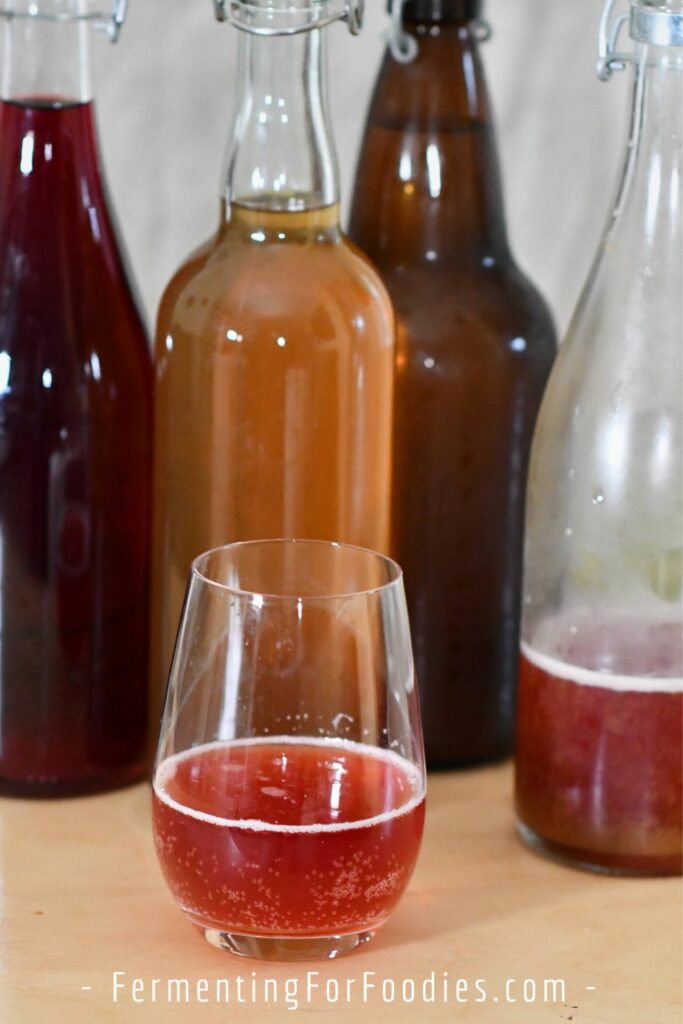Want to learn how to make alcohol? Here is everything you need to know about how to brew beer, wine, cider, and more!

People have been making alcoholic beverages since at least 10,000 BC. All that is required is yeast, sugar, and a container to ferment in. However, things get more tricky if you want to make something that actually tastes good!
NOTE: Every country has its own laws about homemade alcohol. Please follow your local rules and regulations before making homemade alcohol.
How to make alcohol:
Here is an overview of everything you need to know to make alcohol. This information is the same whether you are brewing beer or wine. For specific recipes and details about a particular type of alcohol, see the section below.
The basic steps
- Sanitize everything: It’s important to make sure that all your equipment and bottles are sanitized. It’s the best way to prevent bad-tasting homebrew.
- Primary Fermentation: Primary fermentation is the first round of fermentation when the yeasts are actively converting sugar to CO2 and alcohol. This is best done in a large jug with an airlock which will allow CO2 to escape while preventing contamination from mold and wild yeasts. (See photo below).
- Secondary Fermentation: Secondary fermentation is actually more about conditioning and flavor development. After fermenting for 2 to 4 weeks, the liquid is racked (moved) to a clean container to remove dead yeasts and other solids. Then it is left to slowly ferment for another few weeks.
- Stopping Fermentation: As long as the conditions are right, the yeast will keep fermenting until the sugars are gone or until the ferment reaches the maximum alcohol tolerance for that type of yeast. (From 5% for wild yeasts to 18% for champagne yeast.) You can prematurely stop fermentation by refrigerating your ferment or adding sulfur dioxide.
What do you need to buy?
There really isn’t any specialized equipment required for homemade alcohol. However, it is handy to have a little more control if you want to make great-tasting beverages or if you are planning to store your homemade alcohol for more than a week or two.
- Tubing: Food-grade tubes and an auto-siphon are useful for moving liquids between carboys and bottles. They generally run at about $20 and are worth the investment.
- Airlocks: Airlocks are very important if you are serious about making alcoholic ferments. It allows the CO2 to escape while maintaining a sterile fermenting environment. In general, I recommend cylindrical airlocks because they are easier to clean than S-shaped airlocks.
- Hydrometer: A hydrometer measures the approximate alcohol levels of your beverage by comparing the amount of sugar before fermenting and after fermenting. Here’s my tutorial on how to use a hydrometer.
- Chemicals: There are several chemicals that are frequently used in wine and cider making to ensure fruit ripeness, total acidity, and pH. If you are planning on making wine or cider, then I recommend reading about the necessary supplies.

Different Types of alcohol:
Here is a brief overview of the different types of alcoholic ferments, with links to more information and recipes.
- Beer: Beer is made from fermented grain. First, the grain is malted to increase the sugar content and improve the flavor. Then hops are added for flavor and preservation. Beers generally range from 4%-8%.
- Fruit Wine and Cider: Cider and wine are both made from fruit and follow the same recipes. Cider is capped off early so that it is sparkling with an alcohol level of 3%-12%. Wines are fermented until they reach 12%-14%.
- Mead: Mead is another traditional form of alcohol made from raw honey. It can range between 8%-20% ABV.
- Rice Wines: There are many types of alcoholic rice beverages, and the process is more similar to beer than wine. Rice wines generally range from 18%-25%.
Two beginner Friendly Recipes
- Fruit juice cider: If you have never made alcohol before, then try starting with this cider. It’s an easy recipe made from a bottle of juice and yeast. And it only takes a few days to make a sweet and sparkling cider.
- Bread Kvass: Kvass is an easy version of beer. It is made from toasted bread (rather than grain) and is enjoyed when it is still sweet and sparkling. It is an easy ferment for beginners, as it doesn’t need any specialized ingredients or equipment.



Can I ask you if you have any recipes so I can brew some my own it would be helpful thank you for your time
Are you wanted to brew beer? Here’s my recipe for an oatmeal stout: https://www.fermentingforfoodies.com/classic-oatmeal-stout/
I’ve also made an IPA, but haven’t written up the recipe yet. 🙂
Great
What exactly does it mean to rack the cider liquid before bottling. I think I know but want to make sure.
Racking is when you use a siphon to move liquid from one jug to another. The goal is to remove the dead yeasts which are settled on the bottom of the jug, while avoiding oxygenation. Cheers!
please help me to make homemade ginger beer and wine for commercially .
I’m not sure what you are asking? However, feel free to follow my recipes. I think the trick to commercial brewing is to follow all the local rules and regulations around food preparation and safety. Good luck!
I’m trying to make blueberry shine but after letting the mash ferment there is very little alcohol content . Can it be started over
Hum… I’m guessing you made it without commercial yeast? Wild-yeast ferments seldom become very alcoholic. So if you want to increase the alcohol levels add a bit of wine yeast. Cheers!
Pls if am to start as a beginner, what are d implements and ingredients to use.
pls i need d recipes
Hi Tayo, I have guides for brewing beer, cider, or wine. You can find them here: https://www.fermentingforfoodies.com/category/alcohol-2/ They include everything you need to know and have step-by-step videos too! 🙂 Cheers!